by Lacey Cooke | Dec 3, 2018 | 01 What's New, Ancestry, DNA |
Get a new perspective on your DNA results with AncestryDNA’s new Genetic Traits feature. For just $10, you can discover how traits run in your family and might even come from ethnic origins, with no additional DNA test needed. It’s a deeper look into what makes you YOU, and it’s a fantastic way to engage non-genealogists in your family to be interested in where they come from.
Share Traits This Holiday Season
While the new Genetic Traits feature from AncestryDNA may not be directly applicable to genealogical research or uncovering brick wall ancestors, it’s the ideal tool to interest the non-genealogist in your family. Your relatives might not be interested in cousin-matching and identifying shared ancestors, but they will love discovering what makes them unique. The Genetic Traits tool provides another vehicle for people to discover their origins and connect with their past in a meaningful way. If you’re giving a DNA test kit as a gift this year, consider gifting the Traits feature as well. And have fun exploring your own traits! Order now at Ancestry.com or on Amazon.
New AncestryDNA Feature: Genetic Traits
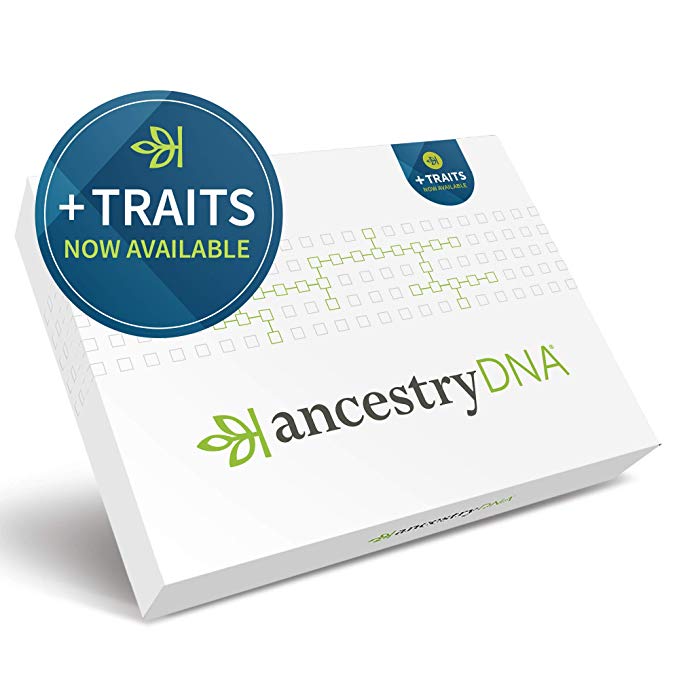
November 9, 2018: “Ancestry’s long history of innovation has driven our leadership in family history and, more recently, the emerging field of consumer genomics. Today, we’re proud to introduce a fun and innovative way for you to further explore who you are and where you come from – AncestryDNA Traits. Using science and data to power ongoing journeys of discovery, Traits is a new interactive experience that allows you to discover traits and attributes influenced by your DNA. With AncestryDNA Traits, you can explore up to 18 traits and attributes that you’ve inherited from your ancestors, share with family, and may pass down to future generations.”
Through AncestryDNA Traits, people can:
- Identify 18 traits (full list below)
- Compare your genetic markers to your matches via the AncestryDNA mobile app to see who in your family you share certain traits with.
- Explore an “Around the World” interactive map, where you can see how your traits align with your heritage.
- New customers can upgrade their AncestryDNA kit to include Traits for an additional $10.00 on Ancestry.com and Amazon. Existing customers can purchase the Traits feature for $10.00 through their Ancestry account.
Identifiable Traits
With AncestryDNA Traits, customers can explore up to 18 traits and attributes including:
- Finger length
- Cleft chin
- Earlobe type
- Earwax type
- Eye color
- Freckles
- Hair color
- Hair type
- Hair strand thickness
- Iris patterns
- Male hair loss
- Skin pigmentation
- Unibrow
- Bitter taste perception
- Sweet taste perception
- Savory taste perception
- Asparagus metabolite detection
- Cilantro aversion
More About Traits
From Ancestry: “Powered by AncestryDNA, Traits gives you an even deeper look at your personal story through the “Around the World” interactive map. You can explore how your traits align with your heritage and learn whether your green eyes are common in other people with Irish ancestry.
Those of you with the AncestryDNA Mobile app will be the first with access to our new Traits Compare feature which allows you to compare your genetic markers that influence your traits with friends, family, or any other AncestryDNA customer who has Traits.
Traits is just the latest example of the many tools we’re working on to enable a journey of personal discovery that we hope will enrich your life. As in everything we do, protecting your privacy is our highest priority, so we will continue to place you in control of your data – that means both you and your counterpart must consent to participate in any Traits Comparison.”
Lacey has been working with Genealogy Gems since the company’s inception in 2007. Now, as the full-time manager of Genealogy Gems, she creates the free weekly newsletter, writes blogs, coordinates live events, and collaborates on new product development. No stranger to working with dead people, Lacey holds a degree in Forensic Anthropology, and is passionate about criminal justice and investigative techniques. She is the proud dog mom of Renly the corgi.
Disclosure: This article contains affiliate links and Genealogy Gems will be compensated if you make a purchase after clicking on these links (at no additional cost to you). Thank you for supporting Genealogy Gems!
by Lacey Cooke | Nov 30, 2018 | 01 What's New, Records & databases |
U.S. Naturalization Records at MyHeritage top the charts this week for new records collections online. Over 200 million records are available for Illinois, Indiana, Iowa, Wisconsin, Connecticut, Maine, Massachusetts, New Hampshire, Rhode Island, and Vermont. Also new this week are German marriages, baptisms, and burials. Britain marriage licenses dating back to the 12th century may also pique your interest and are available online.
U.S. Naturalization Records
New this week at MyHeritage are over 200 million U.S. Naturalization Records. First is the record index for Northern Illinois, 1840-1950, containing petitions for naturalization filed in northern Illinois circuit court and INS District 9. In addition to Illinois, INS District 9 covered parts of northwestern Indiana, eastern Iowa, and southern and eastern Wisconsin. Data collected prior to 1906 was limited, likely containing just the name of the petitioner, their country of origin, and record dates and numbers. After 1906, you’ll be more likely to see records with not only names, but also addresses, birth dates, witnesses present, and date and place of arrival the U.S.
Also new is the Naturalization Record Index for New England, 1791-1906. This collection is an index of naturalization documents filed in courts in the states of Connecticut, Maine, Massachusetts, New Hampshire, Rhode Island, and Vermont from 1791 to 1906. The 3X5 inch cards in this collection contain limited information. But the 5X8 inch cards will likely contain the name of the petitioner, petition for citizenship, oath of allegiance, record of previous citizenship, place and date of birth, occupation, place and date of arrival in the United States, name of the ship, place of residence at the time of application, and name and address of a witness to these statements.
German Marriages
Genealogy Giant website Ancestry.com has a new collection of Eberswalde, Germany, Marriages, 1874-1936. Within these records, you can find a wealth of information, including names, occupations, birth date, parents, witnesses, and more. Each document has a front and back and are displayed one after the other. Additional events from the life of the couple were sometimes recorded later on in the margins, but these notes are not indexed. In addition to these civil registers, complementary alphabetical directories of names may also have been created. These directories may tell you the names of the bride and groom, occupations, residence, and cross-reference to the marriage register.
Ancestry has also recently partnered with FamilySearch to provide free access to Lutheran Baptisms, Marriages, and Burials, 1500-1971. From the collection description: “This collection contains parish registers from numerous Protestant communities and military garrisons found in former or modern German territories. The records are largely organized according to historical regions and church districts that may differ from current affiliations. These parish records primarily contain information about births and baptisms, marriages, and deaths and burials.” It’s important to note that this collection is in German, so you may want to reference the German Genealogical Word List on the FamilySearch Wiki.
Britain Marriage Licenses
If your ancestors were married in England, you’ll want to explore this great collection of Britain Marriage Licenses at Findmypast. Fifteen English counties are represented including London, Lancashire, Suffolk, Exeter, Lincoln, Yorkshire, and more, and records date back as early as 1115! These marriage licenses may be able to tell you the couple’s names, father’s name, and the marriage location. The collection consists of a mixture of more than 536,000 handwritten and typed record books from 1115 until 1906 provided by the College of Arms, Anguline Research Archives, and Gould Genealogy.
Reconstruct Your Ancestors’ Stories
When records have been destroyed, or simply remain elusive, you can still put the pieces together to discover your ancestors’ stories! In the new Genealogy Gems Premium eLearning Video, instructor Sunny Morton will show you how to reconstruct fascinating experiences from your own family history by combining clues from your family’s knowledge, documents from genealogy websites, good historical research and Googling to fill in the gaps. All while learning the riveting story of one of the worst disasters in U.S. history. Members can watch right now by clicking here. Not a member? Sign up today!
Lacey has been working with Genealogy Gems since the company’s inception in 2007. Now, as the full-time manager of Genealogy Gems, she creates the free weekly newsletter, writes blogs, coordinates live events, and collaborates on new product development. No stranger to working with dead people, Lacey holds a degree in Forensic Anthropology, and is passionate about criminal justice and investigative techniques. She is the proud dog mom of Renly the corgi.
Disclosure: This article contains affiliate links and Genealogy Gems will be compensated if you make a purchase after clicking on these links (at no additional cost to you). Thank you for supporting Genealogy Gems!
by Lacey Cooke | Dec 15, 2017 | 01 What's New, Australian, British, Irish, Records & databases, United States
Exciting news this week is the brand new British and Irish Roots Collection from Findmypast. This collection has 98 million records and is free to search for a limited time. Also new are electoral rolls for Australia and vital records for the United States.

Findmypast: New Collection for Tracing Immigrants From the British Isles
Findmypast has just announced the brand new British and Irish Roots Collection. This exciting new database consists of more than 98 million assorted records that have been hand-picked from existing collections by Findmypast’s in-house experts. It spans more than 400 years of migration between the British Isles and North America, all in one place. And for a limited time, this database is FREE to search for everyone!
A little more about the collection: “Millions of passenger lists, census records, naturalization applications and draft registrations, as well as birth, marriage, and death records spanning more than 400 years (1573 to 1990) of migration between the British Isles and North America can now be explored in one unified search, enabling North American family historians to trace the migration of ancestors from the Old World to the New through one simple search.”
The journeys researchers can expect to find include:
- Anyone leaving the UK or Ireland and emigrating to the US, Canada or the Caribbean
- Anyone emigrating from Canada or the Caribbean to the US (this covers the large number of British and Irish immigrants who stopped temporarily in Canada and/or the Caribbean)
- Anyone listed on any US or Canadian record with British or Irish origins, birthplace or parents
This is a very exciting new collection, and one well-worth exploring now while it’s available for free. Click here to start searching now (a free Findmypast account may be required to view).
Australia – Electoral Rolls
MyHeritage has added new collections for Queensland, Australia Electoral Rolls. Years include 1906, 1941, and 1959. Electoral rolls are the nearest record Australians have to census listings and hence are extremely important to local, social and family historians. MyHeritage has also added the Tasmania Electoral Rolls 1916 collection as well.
Also new this week is Ancestry’s collection for the Queensland, Australia, Mining Accident Index, 1882-1945. From the database description: This collection contains information about mining accidents published annually in the Queensland Legislative Assembly Votes and Proceedings (later known as Queensland Parliamentary Papers) from 1882 to 1945.
United States Vital Records & More
Obituary Notices. Findmypast has a new collection of Obituary Notices containing 6 million records (transcribed from the tributes.com website) that could help you unlock unknown details on your ancestor’s death in America.
Colorado. A new collection of Steelworks Employment Records, 1887-1979 is available now at Ancestry. The original records come from the Steelworks Center of the West, and you may find names, birthdates, birthplaces, spouses, occupations, and more.
Idaho. Two new collections of vital records for Idaho are now online at Ancestry. County Birth and Death Records, 1863-1967 will reveal names, dates, places, and includes a small amount of marriage records. County Marriages, 1863-1967 contains a variety of marriage forms, including: Marriage Certificates, Marriage Licenses, Marriage Affidavits, and Marriage Applications.
Montana. Also new at Ancestry are marriage records for Montana. These new databases include County Marriages 1865-1987, Marriage Records 1943-1986, and Divorce Records, 1943-1986. To obtain certified certificates (or request changes) you’ll want to contact the Montana Department of Public Health and Human Services Office of Vital Records.
New Hampshire. Finally, vital records for Portsmouth, New Hampshire are available at Findmypast. Start with the Vital Records 1706-1895 collection, containing birth, marriage, and death records reported in newspapers and town record transcripts. If your ancestors fell on hard times, you’ll want to search the Expenses Of The Poor 1817-1838 collection. The Newspaper Abstracts 1776-1800 collection may help you sketch a more detailed view of significant events in your ancestor’s life. Finally, cver 10,000 new records from Portsmouth, NH have been added to Findmypast’s collection of United States Marriage records.
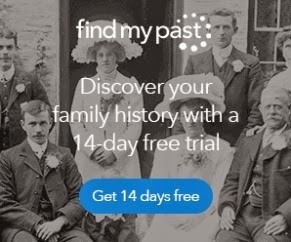 Try Findmypast FREE for two weeks!
Try Findmypast FREE for two weeks!
As we mentioned above, the new British and Irish Roots Collection is free to search at Findmypast for a limited time. But there’s so much more to discover! Findmypast is the leading records website for British and Irish records, and has growing databases for the United States, Australia, and Canada. Get a two-week free trial to explore everything that Findmypast has to offer!
Disclosure: This article contains affiliate links and Genealogy Gems will be compensated if you make a purchase after clicking on these links (at no additional cost to you). Thank you for supporting Genealogy Gems!
by Lacey Cooke | Dec 8, 2017 | 01 What's New, Ancestry, Canadian, German, Records & databases
Big records updates at the Genealogy Giant website Ancestry.com! Brand new collections of birth, marriage, death, and census records for Canada were added this week, along with a Remembrance Book for the 100th anniversary of the Halifax explosion. Additionally, new vital records are now available for Germany.
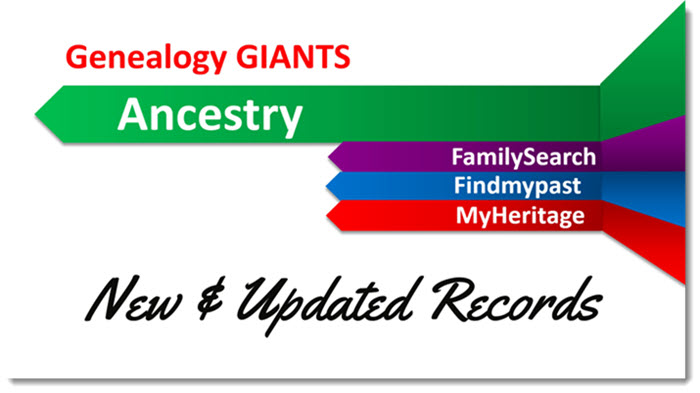
Canada – Birth, Marriage, Death, and Census Records
This year, December 6th marks the 100th anniversary of the Halifax explosion, which was a devastating maritime disaster in Nova Scotia, Canada. Ancestry has recently made available the ‘Halifax Explosion Remembrance Book,’ an online searchable database with detailed information for 1,946 casualties – more than 300 of whom are recently-confirmed and identified victims.
Ancestry also had a huge update of vital and census records this week for Canada:

AncestryDNA for Canada is on sale for just $99! Reg. $129 CAD. Sale ends 12/24/17. Excludes tax & shipping.
Alberta. Explore the new Births Index, 1870-1896, the Deaths Index, 1870-1966, and the Marriages Index, 1898-1942. Note that the marriage index is slightly irregular, in that each image only includes either the bride or the groom and their marriage year.
Newfoundland. Search baptisms and marriage records in the new collection of Church Records, 1793-1899. You’ll also find records from various churches in Newfoundland in the Births, Marriages, and Deaths, 1757-1901 collection, and the Births, Marriages, and Deaths, 1850-1949 collection. Also available are the 1921 Census, the 1935 Census, and the 1945 Census. Those databases originate from the Newfoundland Department of Tourism, Culture, and Recreation.
New Brunswick. New vital records collections start with Births and Late Registrations, 1810-1906. Then you’ll find Marriages, 1789-1950, which include registers, certificates, delayed registrations, and returns. And Deaths, 1888-1938 is also now online.
Prince Edward Island. Baptisms, Marriages, Burials, 1780-1983 is comprised of church records for Prince Edward Island. The Marriage Registers, 1832-1888 collection was created from newspapers, church records, and other sources that may or may not be provided. The Death Card Index, 1810-1913 contains pictures of the index cards from the Prince Edward Island Provincial Archives.
Nova Scotia. Lastly, Antigonish Catholic Baptisms, Marriages, and Burials, 1823-1905 are now available for Nova Scotia. The earlier registers are written in paragraph format, while later registers are typically pre-printed forms with information filled in by hand.
German Vital Records
Lots of new vital records collections for Germany recently became available, starting with Waldshut-Tiengen, Births, Marriages, and Deaths, 1870-1945. This collection of civil registers includes records from 9 additional communities which are today boroughs of Waldhut-Tiengen.
Next are Erfurt, Germany, Births, 1874-1901 and Marriages, 1874-1900. Additional events from the life of the child or the couple were sometimes recorded later on in the margins, but have not been indexed.
You’ll also find Zschopau, Germany, Births, 1876-1914, Marriages, 1876-1920, and Deaths, 1876-1958 now at Ancestry. It may be helpful to note that during the time period of these collections until 1918, Zschopau belonged to the Kingdom of Saxony.
Finally, Traunstein, Germany, Births, 1876-1905, Marriages, 1876-1934, and Deaths, 1876-1978 are also online, where you’ll find names, dates of birth, dates of deaths, witnesses, informants, parents, signatures, and other information.
Get the most out of Ancestry!
 Getting started on Ancestry.com can be a little daunting. As one of the world’s top genealogy websites, it’s packed with information about millions of people–perhaps including your ancestors. These step-by-step instructions will help you start building your family tree and learning more about your heritage. Click to read our recent article Getting Started on Ancestry.com.
Getting started on Ancestry.com can be a little daunting. As one of the world’s top genealogy websites, it’s packed with information about millions of people–perhaps including your ancestors. These step-by-step instructions will help you start building your family tree and learning more about your heritage. Click to read our recent article Getting Started on Ancestry.com.
Disclosure: This article contains affiliate links and Genealogy Gems will be compensated if you make a purchase after clicking on these links (at no additional cost to you). Thank you for supporting Genealogy Gems!
by Lisa Cooke | Sep 15, 2017 | 01 What's New, Ancestry, Cemeteries, Records & databases |
If you’re looking for cemetery records, you’re in luck! This week there have been massive updates to Find A Grave’s global databases at Ancestry.com. But why search Find A Grave at Ancestry.com? We can think of 3 good reasons.
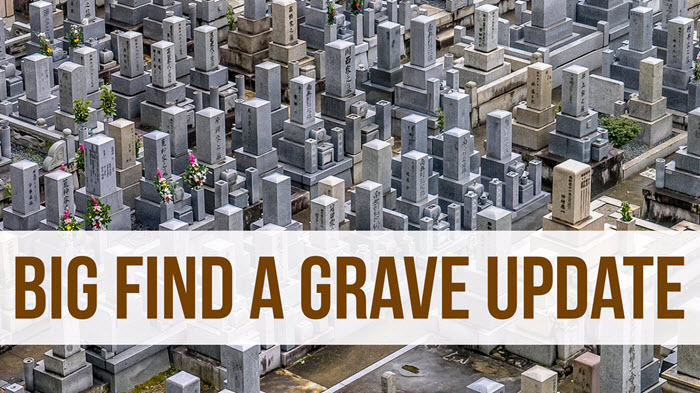
Find A Grave at Ancestry.com: Updated Collections

Did you know you can use Google Earth to find cemeteries? Click here to learn how.
The following Find A Grave collections have all been updated to Ancestry.com, where they can be linked directly to your tree:
You’ll also find these records updated at FamilySearch.com as well.
If there’s a specific grave you’re looking for, ask Find a Grave to help! Click here to learn how to submit a photo request to both Find a Grave and Billion Graves.
Why Use Find A Grave at Ancestry.com?
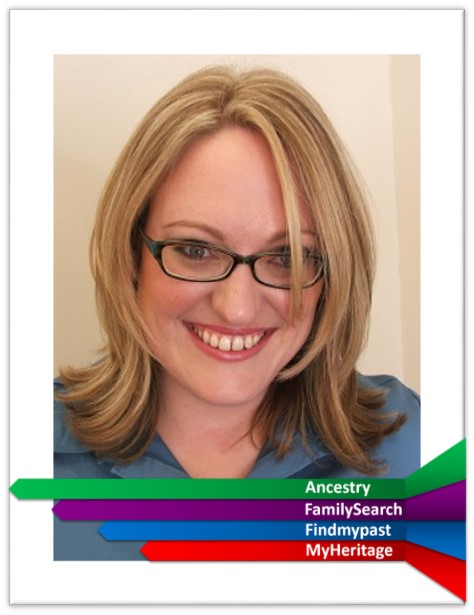
Sunny Morton, Genealogy Giants Guru
Find A Grave is a free website with crowd-sourced tombstone images and transcriptions from cemeteries all over the world. Last we checked, they boast 162 million grave records! Their catalog of cemeteries tops 400,000, spread out over 200 different countries, and they have at least a partial listing of graves for well over half of these (over 250,000).
So why would you go to Ancestry.com to search records that are already free at Find A Grave? Genealogy Gems Contributing Editor Sunny Morton, our resident expert on the giant genealogy websites, says:
“If you’re already an Ancestry.com subscriber, searching Find A Grave from within Ancestry.com may be a good choice for these three reasons:
1. One-stop searching. You’re already searching in Ancestry.com: you don’t need to remember to switch over to search Find A Grave separately for each ancestor.
2. Ancestry.com’s search tool. Find A Grave has a nice but basic search tool. It’s pickier about the search results it returns: does the spelling match? And is a potential result in the exact place you requested? (If you search a specific county, Find A Grave will only return results from that county–not in an adjacent county, across the state line, or even across the country where an ancestor may have been interred.) Lacey has a great example below.
From Lacey: Here’s a search of my 3X great grandfather at Find A Grave:

Unfortunately, no results:
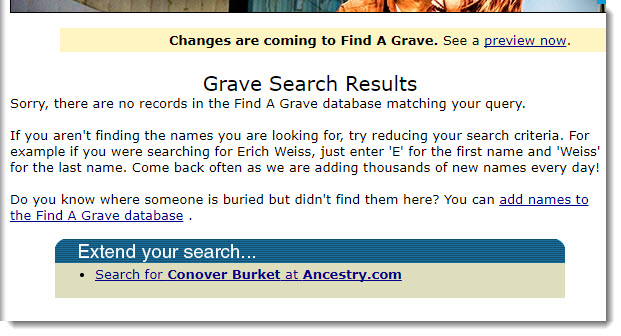
I then hopped over to Ancestry, went to the card catalog, and searched the U.S. Find A Grave Index:
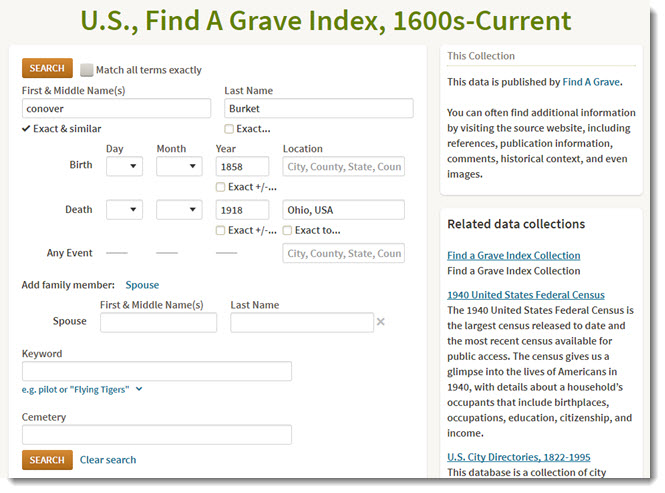
Turns out there was an extra “t” on his surname (see results below). I didn’t search on a partial name because I’ve never come across a different spelling of his before, and I certainly didn’t expect to see one on his tombstone! But sure enough, the name is not spelled as it had been throughout his life. It’s awfully nice that Ancestry could find it:
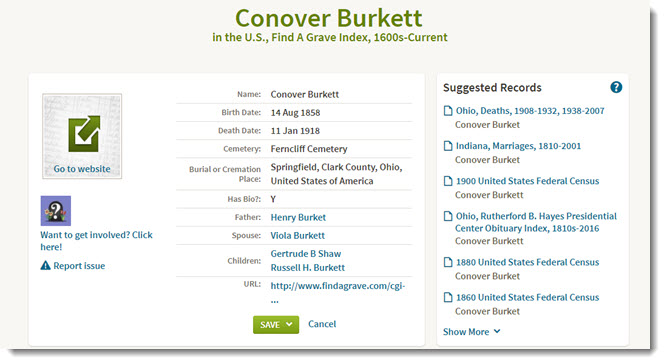
Ancestry.com is much more forgiving and flexible about spelling and places. It will return search result possibilities that don’t have to match exactly. As you can see from the screenshots above, Ancestry offers more fields to enter, including relatives’ names (and people are often buried with relatives), a more detailed place field, and keywords.
3. Tree-building ease. If you build your tree on Ancestry.com, it’s easy to attach Find A Grave search results to your ancestor’s tree profiles. If you search separately at Find A Grave, you have to create a separate source citation to attach to your tree.” (Note: hopefully, if you’re building your tree on Ancestry.com, you’re syncing it to your own software. RootsMagic and Family Tree Maker will both sync to your Ancestry tree–click here to see why Lisa Louise Cooke prefers RootsMagic.)
More Cemetery Resources
 Get detailed step-by-steps for using Find A Grave and Billion Graves, plus guides for understanding tombstone epitaphs and symbol meanings in this brand new book: The Family Tree Cemetery Field Guide. Discover tools for locating tombstones, tips for traipsing through cemeteries, an at-a-glance guide to frequently used gravestone icons, and practical strategies for on-the-ground research.Use coupon code GEMS17 for an extra 10% off! *Coupon valid through 12/31/17.
Get detailed step-by-steps for using Find A Grave and Billion Graves, plus guides for understanding tombstone epitaphs and symbol meanings in this brand new book: The Family Tree Cemetery Field Guide. Discover tools for locating tombstones, tips for traipsing through cemeteries, an at-a-glance guide to frequently used gravestone icons, and practical strategies for on-the-ground research.Use coupon code GEMS17 for an extra 10% off! *Coupon valid through 12/31/17.
https://lisalouisecooke.com/2016/07/cemetery-records/
Disclosure: This post contains affiliate links and Genealogy Gems will be compensated if you make a purchase after clicking on these links (at no additional cost to you). Thank you for supporting Genealogy Gems!










 Getting started on Ancestry.com can be a little daunting. As one of the world’s top genealogy websites, it’s packed with information about millions of people–perhaps including your ancestors. These step-by-step instructions will help you start building your family tree and learning more about your heritage. Click to read our recent article
Getting started on Ancestry.com can be a little daunting. As one of the world’s top genealogy websites, it’s packed with information about millions of people–perhaps including your ancestors. These step-by-step instructions will help you start building your family tree and learning more about your heritage. Click to read our recent article 





